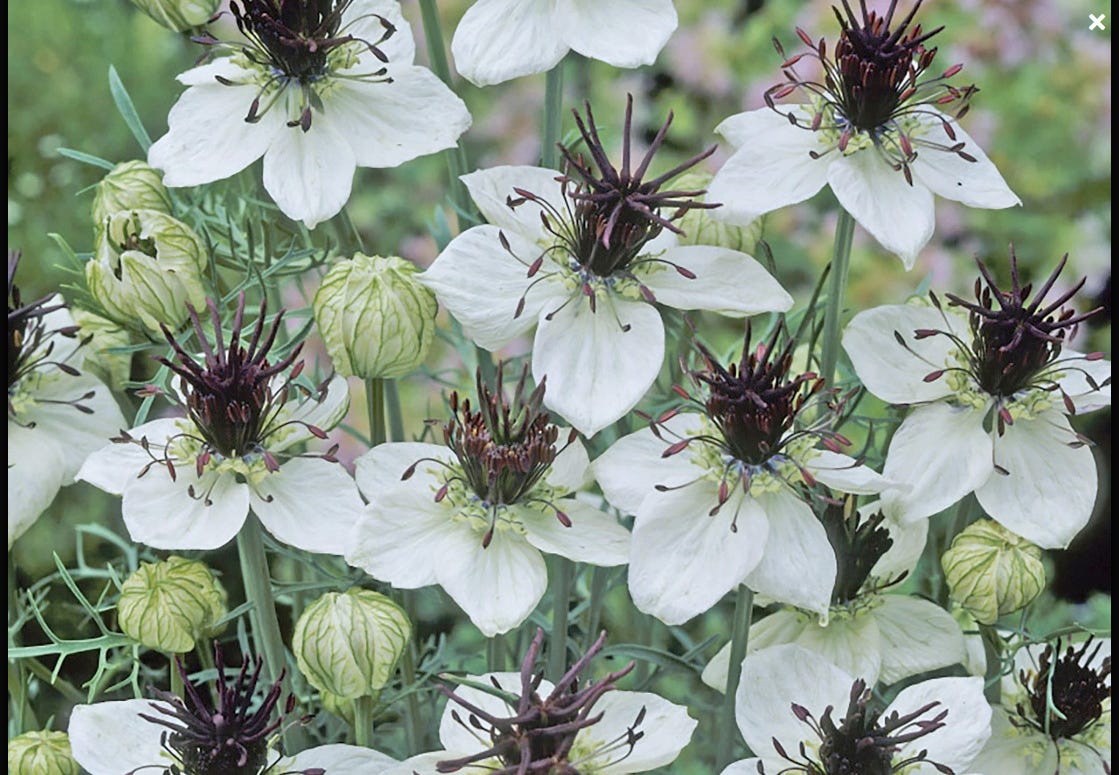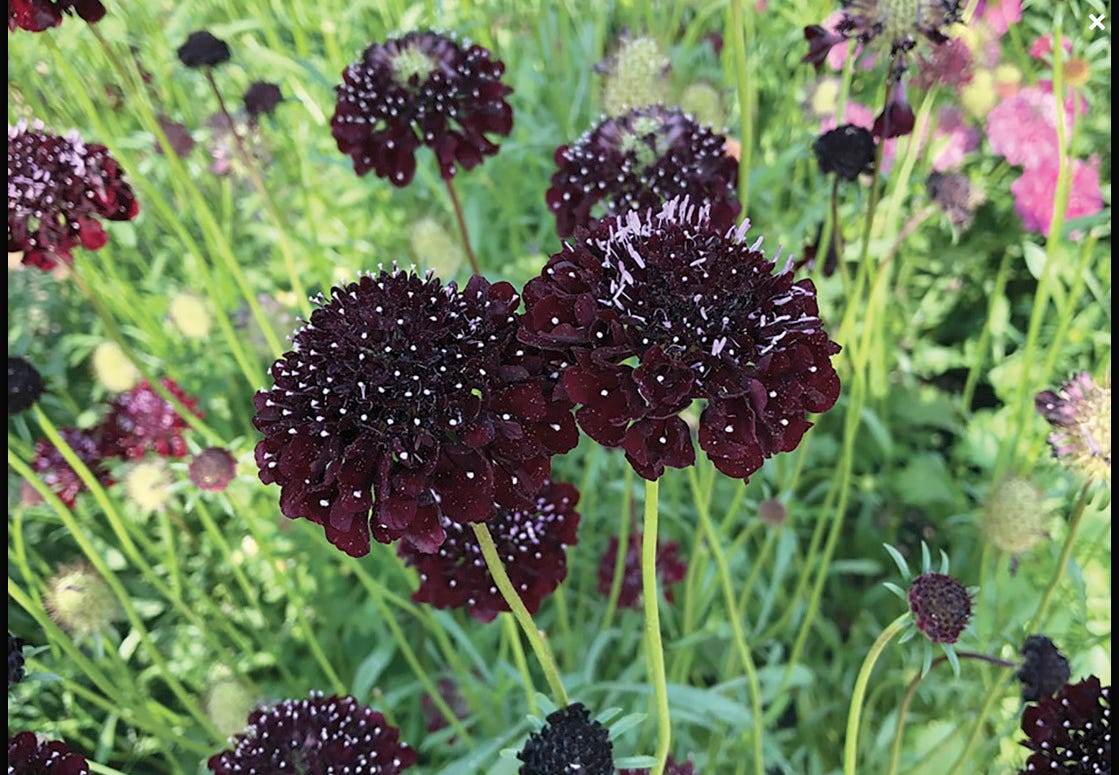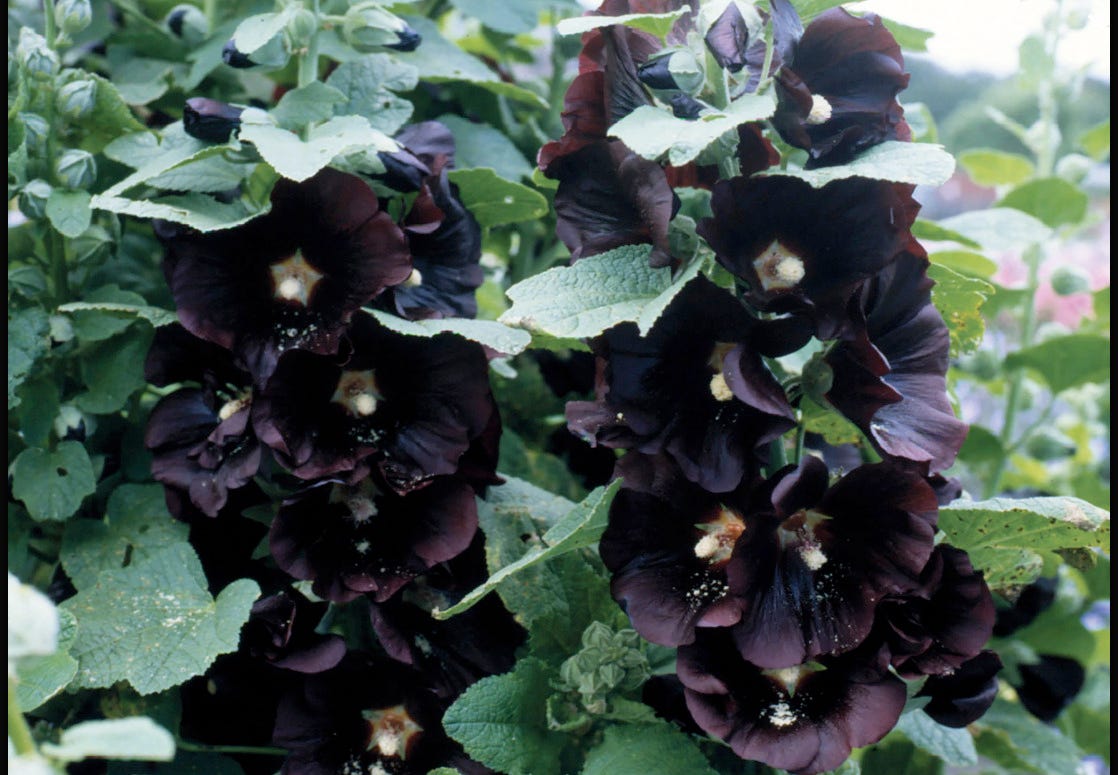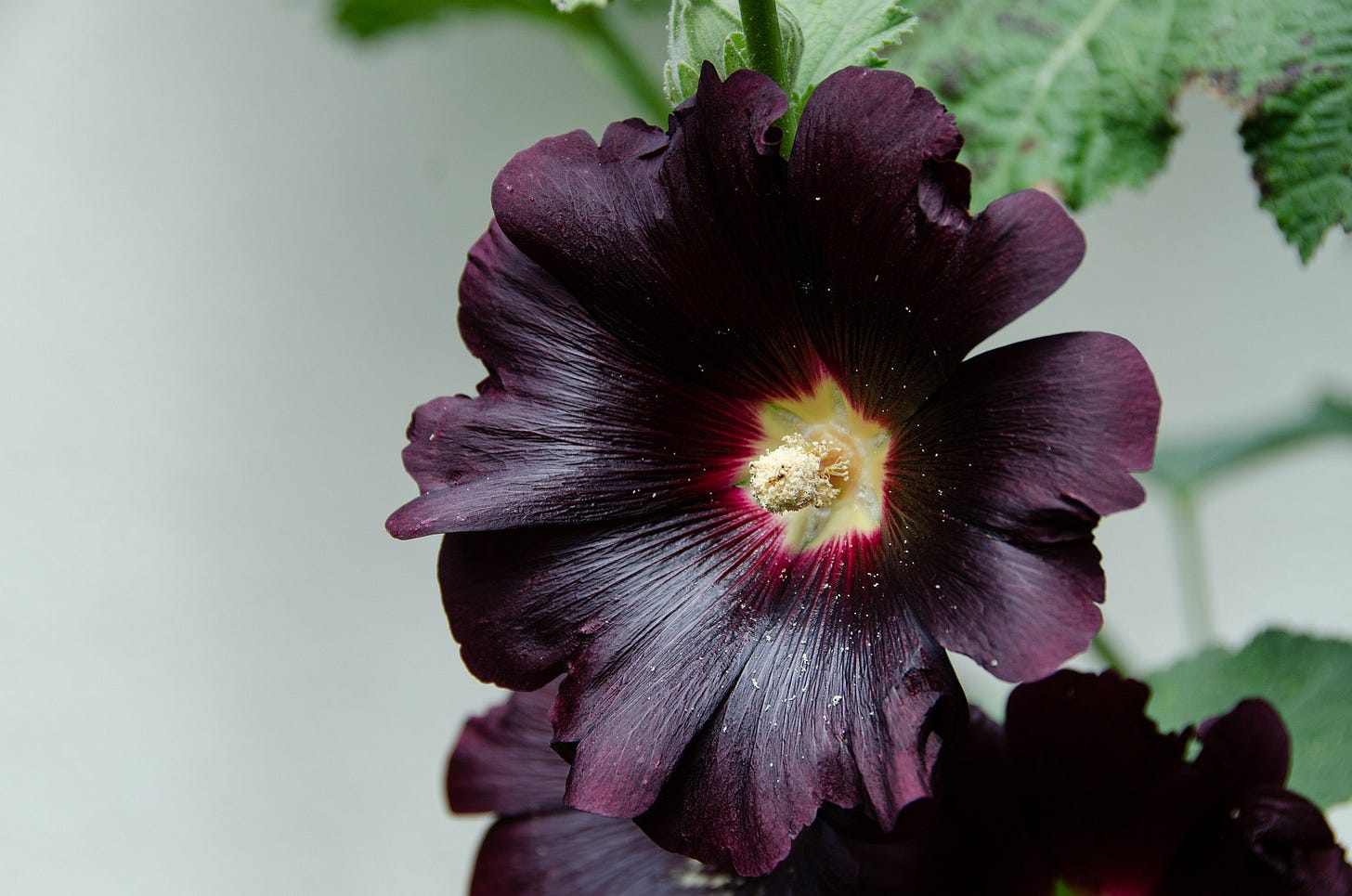You can call them black, purple, burgundy, or maroon — but plants with moody colours have always charmed me.
There is something mysterious about the depth of these plants’ smoky colour, whether on petals, stamens or foliage. But a true black is rarely achieved in the plant world; the colour you see is just the darkest version of another colour and it can be the life’s work of plant breeders to find it.
A florist site made me laugh when I read it’s recommendation for giving black flowers:
They symbolise power, mystery, elegance, farewell and goodbye. Often the romantic message of black flowers is a negative one, so these should probably be saved for break-ups.
Nevertheless, growing these plants in the garden provide an opportunity to see how the “black” changes in sunlight, whether pinks or reds appear at the edges, or how the depth of colour shimmers in daylight and then deepens at dusk.
This Love-in-a-Mist with dark maroon stamens was developed by a husband and wife team of plant breeders in 2004. Of the two, Elisabeth Sahin-Georgiadou, Cypriot by birth and trained in Reading, UK, is a horticultural botanist. With a PhD in taxonomy and Biosystematics, she and her husband, Kees Sahin, ran a well-regarded private seed company in the Netherlands. They became leaders in developing notable flower varieties, numerous among them award winners. By 2007, they had production taking place in eleven countries and in 2015, she was awarded the All America Selections Award of Honour for her contribution to plant breeding.
Not only is Nigella ‘African Bride’ easy to grow from seed directly tossed into the soil in the spring, but it will flower from July through September on three foot tall sturdy stems. It needs a sunny site, and you may be rewarded with the sight of hummingbirds enjoying the blooms. With an attractive bulbous seed-head, it provides an interesting display even when the flowering is over.
This dainty and diminutive dianthus, known colloquially as “pinks”, only reaches about 14” on glaucous blue/green stems with spear-shaped foliage. The flowers are double and frilly and almost black with white edges, and are best shown off en masse for a striking effect. And the 1” blooms are sweetly scented, making growing them a multi-sensory experience.
It can be directly sown into the garden three to four weeks before final frost date (in Ottawa, that’s late April, early May), but choose a sunny site with soil that hasn’t been amended too heavily. Choose the front of the garden bed as they are shorter than most other flowering plants. Characterized as being both a hardy annual or tender perennial, that means that in our climate this plant can self-seed and return the following year OR return as the same plant if given a well-protected site. By well- protected, I mean next to a warm foundation or on a south-facing slope, and covered by evergreen boughs or straw to insulate it from the cold.
This gorgeous pincushion flower is one of the darkest annuals out there. With white flecks on the tips of the mounded blossoms, it is cousin to the perennial blue Scabiosa, but this one rewards the gardener who starts seeds indoors (seeding to bloom time is sixteen weeks, so start counting!) with blooms all summer long. It reaches almost three feet in height, and flowers will continue to appear on the tops of wiry stems the more you deadhead. Loving sunny or partially sunny locations, keep the soil on the thin side for this annual and you’ll see bees and butterflies visit this striking plant with a sweet honey scent. And as a bonus, you won’t have to worry about deer eating them!
Purple-black Scabiosa is prefaced by the abbreviation QIS which means ‘Quality in Seed’, signifying a strain that is superior over standard seed varieties. That means things like stronger, more reliable colour development as well as larger blooms that last the entire season.
Dark-flowered Scabiosa have their origins in Scabiosa atropurpurea, a species native to southern Europe and beloved in the UK from the 1600s, known as Blackamoor's Beauty or the Mournful Widow. Although the species is termed ‘atropurpurea’, meaning “very purple” (from the Latin ‘atrox’, meaning ‘very’), the flower colours in this wild species are highly variable ranging from white, rose, blue, crimson and deep purple. This provides a challenge for breeders and it has been met in this sophisticated and elegant strain.
Another lovely annual that has its roots in its blue parent, this bachelor’s button is an explosion of dark purple petals with a darker centre. It doesn’t transplant well so sow it directly in the garden when you’re able to work the soil in the spring. It won’t disappoint you, springing up with grassy blue-green foliage and copious buds opening up into these dark purple sparklers. Like Scabiosa, it reaches about three feet and blooms from late spring through to fall. Bees and butterflies are attracted to it but thankfully deer are not.
One of my favourite cottage garden flowers is the ancient hollyhock and especially this velvety black form. A biennial or short-lived perennial rather than annual, sow this seed in the garden this spring and you’ll have a rosette of foliage this summer, with the six to eight foot tall flower stalks next year. Let the flowers go to seed so that you can plant them the following spring and have a regular succession of these beauties.
I’ve seen hollyhocks growing anywhere, even in cracks in concrete. If they are given too rich a garden soil, they will likely need support to keep them upright, like drunken sailors.
This is an antique variety that has been grown for centuries, including at the famous gardens of Thomas Jefferson at Monticello. Plant them at the back of a border or along a garden fence and soak the seeds before you plant them. Make sure you give them good air circulation to prevent hollyhock rust (rust-coloured pock marks on the leaves that can lead to serious disfigurement) and combine them with yellow or gold late flowering perennials for a great contrast.
You’ve hit the trifecta with hollyhock as they attract bees, butterflies and hummingbirds so your garden will be buzzing with activity.
You may have seen this annual in your British gardening books, both in garden beds and perhaps as a thriller in containers. It is a striking plant with glaucous blue foliage resembling eucalyptus and dangling maroon bells emerging from purple tinged bracts. Elegant and novel, it is a sought-after plant amongst gardeners looking for something different. This selection has 3’ long, sturdy stems, great for cutting and stay upright in the garden, forming a bushy show.
This is an annual that benefits from sowing indoors (first soaking the seed) and planting out when all danger of frost is past. It wants full sun and consistent moisture to stay happy in the garden. Combine it with more delicate plants like either Queen Anne’s Lace or wild carrot for a sophisticated display.
Not technically black or even dark maroon, nevertheless this gorgeous Shirley poppy is an astonishing array of shades of mauve, silvery grey and soft pink that is nothing less than spell-binding. It is a rare variety and you’ll be lucky to get your hands on it, but only if you act quickly!
Shirley poppies reach up to 2’ tall with papery flowers that sway in the breeze on languid stems. You’ll want to sow them directly outdoors either four weeks before last frost (they are hardy annuals so can withstand cold temperatures - you can even scatter them on the remains of the spring snow) - or in late autumn. They require light to germinate so don’t cover the seeds; they will take 5-14 days to sprout and don’t worry if they sprout while it’s still cold - they’ll be just fine.
As I’ve been scrolling through William Dam’s online seed catalogue, like many of you doing the same thing with dozens of catalogues, I’ve seen other annuals that I’ve had experience growing both as cut flowers and as a colourful highlight in my vegetable garden. Granted, my first attempt at an allotment vegetable garden years ago started wonderfully, with tidy beds bordered with straw pathways, seedlings neatly ordered and staked. And then, I don’t know what happened …. chaos ensued! But that’s a story for another day….
NOTE: All the seeds I’ve talked about here can be found in the William Dam Seeds catalogue, available online at: https://www.damseeds.com/











I love the Nigella "African Bride"!! I want some, but darn, I just sent in a seed order. However, you got me browsing the William Dam Seeds catalogue, and I might just have to order some more. Hmmm, will I have enough room in my garden for all these delights? Gardening in January is full of possibilities without all the toil that makes it happen. Thanks, Ailsa, (I think!) for expanding my gardening horizons again!